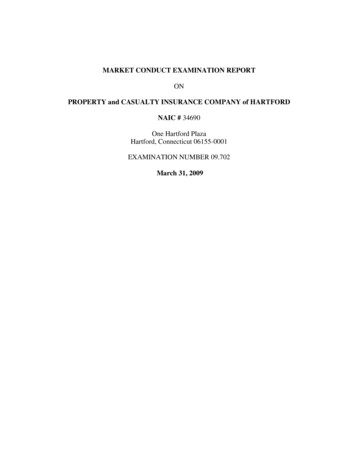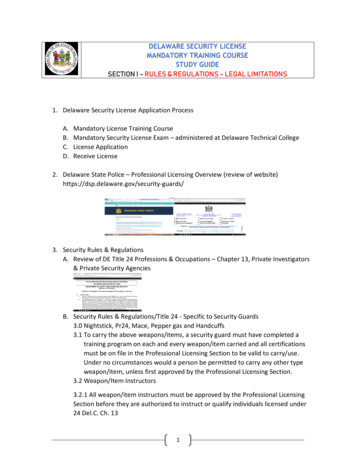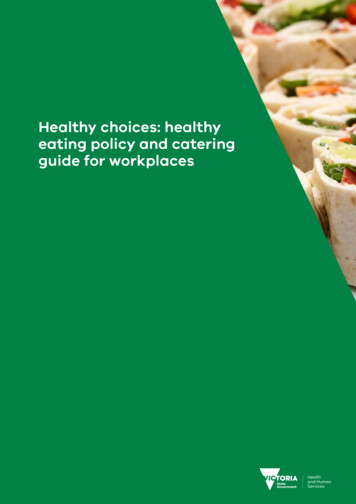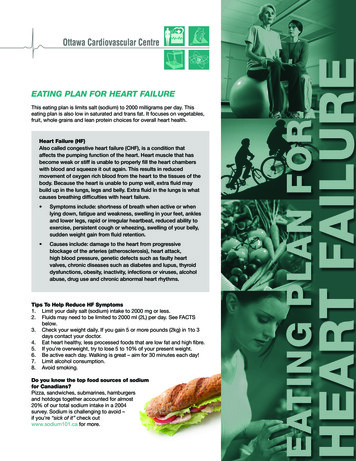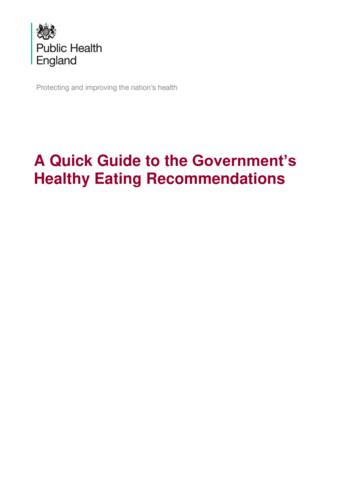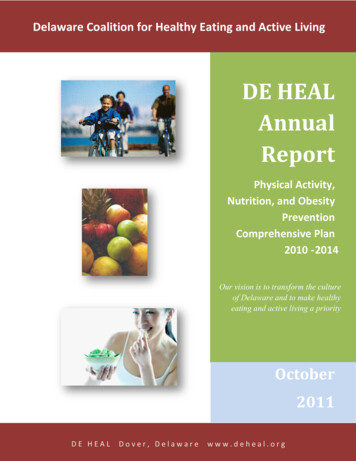
Transcription
Delaware Coalition for Healthy Eating and Active LivingDEHEALAnnualReportPhysical Activity,Nutrition, and ObesityPreventionComprehensive Plan2010 - ‐2014Our vision is to transform the cultureof Delaware and to make healthyeating and active living a priorityOctoberD EH E A LD o v e r ,D e l a w a r ew w w . d e h e a l . o r g2011
Dear Members, Partners, and FriendsAs the burden of obesity and obesity-related chronicdisease continues to weigh on the health ofDelaware, collaborative engagement is the key toaddressing the critical challenges that impact thehealth of the dynamic and diverse communities in ourstate. The motivation to advance the mission of theDelaware Coalition for Healthy Eating and ActiveBrian Rahmer, Chair DEHEAL CoalitionLiving comes from the recognition that together wecan accomplish what each partner cannot accomplish alone.The commitment, resourcefulness, and expertise of DE HEAL members, alongwith the organizations and communities they represent, exemplifies the power ofthe collaborative process and serves as the foundation for realizing our sharedvision: To transform the culture of Delaware to make healthy eating and activeliving a priority.To say I am proud to serve as the Chair for such a dedicated coalition would be anunderstatement. The members of DE HEAL and the community partners withwhom they collaborate have already notched several noteworthyaccomplishments such as the Access to Healthy Foods Forum and thedevelopment of a shared vision, mission, and values.I applaud the efforts of the 70 organizations and more than 200 members thatmake up DE HEAL. Let us continue to work to make Delaware as healthy as it canbe. I look forward to sharing many more achievements and would like to thankthe Delaware Division of Public Health for continued support.Yours in Good Health,Brian RahmerChair, Delaware Coalition for Healthy Eating and Active Living
DE HEAL Annual ReportTable of sandBehaviorHighlights4467I.Letter from the ChairII.IntroductionIII.DE HEAL: Making a DifferenceIV.V.Environmental Scan8DelawareHEALDataSnapshot8VI.Model for Change in l DataSetting Progress ReportsVIII. Future Initiatives21Leadership Team 2011- ‐20122223IX.X.Members
DE HEAL Annual Report 2011In September 2008, the organization now known as Delaware Coalitionfor Healthy Eating and Active Living (DE HEAL) came together by attending asummit sponsored by the Division of Public Health to discuss the health andfitness, nutrition, and the growing problem of obesity in Delaware. At the close ofthat summit the partners recognized the need for a strategic plan for the state ofDelaware and agreed to organize and work on developing it. DE HEAL partnersintroduced a comprehensive strategic plan at the second annual summit inSeptember 2009.The DE HEAL Coalition andnetwork has grown to nearly 200individuals (including 70members) representing about 65stakeholder organizations. Thethird annual summit “Showcasingour Successes” was heldNovember 2010 to report on theprogress made by the Coalition.DE HEAL is proud to present its first report of progress on the Physical Activity,Nutrition, and Obesity Prevention Comprehensive Plan for 2010-2014. Much hasbeen accomplished with the commitment of the elected leadership team to drivethe planned objectives forward with the support and resources of the Division ofPublic Health.1 Page
DE HEAL Annual Report 2011DE HEAL is making a DifferenceVisionOur vision is to transform the culture of Delaware and to make healthy eating andactive living a priority.MissionDelaware HEAL supports and encourages programs, environments and resourcesthat promote healthy eating and active living to reduce the prevalence ofoverweight, obesity and related chronic diseases.Values, Beliefs and Principles1. We value participation and involvement of our Coalition and networkpartners.2. We trust that our members will maintain ethical standards and integrity intheir work with the Coalition.3. We assist each other on the development, implementation and evaluationof initiatives that can impact the mission of DE HEAL.4. We lead, promote, and advocate for solutions and policies that advance ourmission.5. We are a resource and provide expertise in healthy eating and active livingfor public and private agencies.2 Page
DE HEAL Annual Report 2011The DE HEAL Partners are making a difference in Delaware by acting together in acollaborative way to increase the level of awareness about the importance offocusing on obesity prevention initiatives. The DE HEAL Partners work in settings(or committees) organized in accordance with the comprehensive plan and formad hoc committees to work on the implementation of objectives.While specific accomplishments will be reported later in this document progresshighlights include: The completion of the “tool kits” by the Environmental Setting andsubstantial progress on the health care “tool kit” by setting members Increased awareness statewide to policy makers and stakeholderorganizations about the issues and actions identified in the comprehensiveplan Development and launch of a website (www.deheal.org) Sustainability of the organization through the approval of by laws andsecond election of a leadership team at the annual meeting in May 2011 Hosted the forum on Access to Healthy Foods in the Built Environment inNew Castle County3 Page
DE HEAL Annual Report 2011Environmental ScanSubstantial change has occurred in our social, economic and political environmentsince the development of our comprehensive plan. These changes will impact thework of the DE HEAL Coalition. This report lists the socio-economic and politicalchanges identified by the DE HEAL network in a brainstorming discussion at theFebruary 17, 2011 quarterly meeting. The coalition participants were asked“what has changed since our last plan within the economy, policy, business andconsumer attitudes and behaviors?” The following information is not scientific innature; however, the following are highlights obtained from the discussion:The Economy HighlightsAt the onset of our planning process, the United States was beginning what wasjust the start of an economic recession which has not diminished. The followingeconomic issues were identified:Higher fuel prices.Higher food prices.Higher rate of unemployment andpoverty which is draining Delaware’sfood banks.Higher costs of doing business.Health Policy HighlightsHealth care policy at the national level and in Delaware is evolving. The PatientProtection and Affordable Care Act, the federal health care reform law, wassigned into law by President Obama in December 2010. However, its adoption4 Page
DE HEAL Annual Report 2011into law has been challenged in the federal courts and its full implementationremains in limbo. Other policy issues include:The 2010 US Census showscontinued increases in diversepopulations, especially Latinos.The demographic shifts willcontinue to impact health careservices nationally and inDelaware.New dietary and physicalguidelines were issued by theCenters for Disease Control in2010 which provide neededguidance to consumers,businesses and policymakers.Also in 2010, the federal government reauthorized the child nutritionprogram.First Lady Michelle Obama’s campaign (http://www.letsmove.gov/) againstchildhood obesity has heightened awareness about the childhood obesityepidemic. As a result of her leadership and commitment to this area, fastfood chains are beginning to make major changes to menus and displayingcaloric content.There has been a shift in government and public attitudes toward financingprojects and less funding is available.Limited federal funding is impelling the need for multi-agency, multi-sectorcollaboration at the state and local level.In Delaware, Governor Jack Markell signed Executive Order 4 into law April2009, creating a Complete Streets policy, recognizing walking and bicyclingas modes of transportation that are fundamental to healthy lifestyles andencouraging multimodal transportation planning.5 Page
DE HEAL Annual Report 2011On May 20, 2010, Governor Markell issued Executive Order 19 ordering thecreation of the Council on Health Promotion and Disease Prevention (CHPDP)which has elevated the importance of addressing chronic and lifestyle-relateddiseases and solidifies the need for cross-sector collaboration.Business HighlightsConsumer demand has begun toshape business decisions on thesale and service of healthier foodalternatives.Organic foods which were oncefound only in specializednutrition stores are becomingsomewhat more affordableand are integrated with otherproducts in grocery stores.More social marketing and public relations about high sodium and high fatcontent foods has influenced food manufacturers to reduce sodium andtrans-fat.The Restaurant Association has yielded to public pressure to improvehealthy menu options. Major restaurant chains are beginning to introducehealthy food menu options and are showing calorie counts for selections.Private health insurance is starting to make changes encouragingpreventive health through support of wellness programs.Private industry is assuming some responsibility for employees’ wellbeing and supporting preventive health measures.The healthcare industry, in response to quality, safety, access andaffordability, is turning to electronic medical records and values baseddesign and meaningful use measures.6 Page
DE HEAL Annual Report 2011Consumer Attitudes and Behaviors HighlightsThe high cost of living has helped to shift consumer attitudes and behaviors in anumber of areas.There is greater interest on the part of consumers in understanding thefood chain distribution and purchasing local produce.There is a shift in consumer attitudes toward housing in communities and theamenities with more focus on complete communities.The high cost of fuel has contributed to declining automobile driving rates.Discussions about railroad travel and multimodal transportation are returning.People are reengaging in outsideactivities and recreation.The high cost of food andincreased healthconsciousness has helped toincrease community andurban gardening.Canning of fruits andvegetables, an interest of pastgenerations, is now growing inpopularity.Social media is growing as a major form of communication for consumers andbusiness.Attendance to gyms and physical fitness has increased in Delaware – since 2009.The data shows now 51% of Delawareans are now participating in a gym or areactive in physical fitness.7 Page
DE HEAL Annual Report 2011National DataThe 2010 Behavioral Risk Factor Survey (BRFSS) data confirm that no state metthe nation’s Healthy People 2010 goal to lower obesity prevalence to 15 percentwithin the past decade. It will take time to win in the fight against obesity; wemust continue to address it with our very best knowledge and resources. There isno single or simple solution. This epidemic is as complex as its solutions.Strategic approaches must involve multiple levels and sectors to makesustainable, long-term changes. DE HEAL is committed to empoweringcommunities to solve specific health problems such as inactivity, poor nutritionand obesity, and related chronic disease risk factors.OBESITY TRENDS* AMONG U.S. ADULTSBRFSS 1990, 2000, 2010(*BMI 30, or about 30 lbs. overweight for 5’4” person)199020002010No Data 10%10%–14%15%–19%20%–24%25%–29%Delaware HEAL Data SnapshotThe BRFSS, a CDC*-supported surveillance system, collects state-level publichealth data and provides one way for Delaware to monitor progress towardnational and state health goals. Obesity continues to be a major public healthproblem. Obesity related conditions include heart disease, stroke, type 28 Page 30%
DE HEAL Annual Report 2011diabetes and certain types of cancer. While obesity prevalence varies acrossstates, the trends remain high and continue to increase. In Delaware, theprevalence of obesity nearly doubled in the state from 14.4 percent in 1990 to28.2 percent in 2007. Four years later, the obesity rate remained relatively stable.Of concern is the rise in the prevalence of obesity and related chronic diseases inKent and Sussex Counties.African-American adults in Delaware are more likely to report being obese thannon-Hispanic whites or Hispanics, according to the Delaware BRFSS.Significant Disparity for Obesity in DelawareBetween White and African-American Adults: 2010Percent of Delaware Adults100%90%80%70%60%50%40%30%20%10%0%9 Page62.9%74.8%26.1%41.1%36.8%33.4%WhiteBy RaceAfrican American
DE HEAL Annual Report 2011Health habits established in childhood often continue throughout the life span,and many health problems in childhood like obesity and poor oral health,influence health into adulthood. Effective policies and programs are important tothe establishment of healthy habits, the mitigation of risk factors for disease andoverall improved health outcomes for Delawareans.According to the 2010 BRFSS Survey, which uses a new methodology combininglandline and cell phone data, the obesity trend continues to rise. There is stillmuch work to be done.Obesity Doubled Among Delaware Adults1990-2010100%Percent of Delaware Adults90%80%70%60%Methodologychanged tomixed mode,50%40%30%20%10%0%1990 1991 1992 1993 1994 1995 1996 1997 1998 1999 2000 2001 2002 2003 2004 2005 2006 2007 2008 2009 2010Obesity 14.4 15.5 13.0 13.5 15.1 17.1 17.7 18.8 17.2 17.5 16.6 20.8 22.4 24.0 21.1 23.4 26.0 28.2 27.8 29.6 31.5Year*Center for Disease Control and Prevention10 Page
DE HEAL Annual Report 2011Model for Change in DelawareThinking of policy, systems and environmental changes, the DE HEAL Coalitionfocuses on multi-agency, multi-organizational and multi-sector areas to impactindividual, population, and multi-system behavior changes in Delaware.Policy AlignmentHealthEducation EnvironmentEconomyEnergy andTransportationSetting Progress ReportsSix settings or committees were organized following the creation of thecomprehensive plan in September 2009. The settings are led by co-chairs ineach of the following areas: Families in Communities; Schools; Worksites;Health Care; Social Marketing & Communications; Environment and Policy;and Sustainability. Setting co-chairs shepherded the implementation processthrough ad hoc committees for objectives with target dates of 2010-2011. Thead hoc committees included coalition members and network partners whichmet on a regular basis to develop work plans and tactics and carryout thework. The progress report on the next several pages follows the same order aswas contained in the 2009 Comprehensive Plan and covers the period ofOctober 2009 through August 2011.11 Page
DE HEAL Annual Report 2011FAMILIES IN COMMUNITIESFAMILIES IN COMMUNITIESSetting Co-Chairs: Marianne Carter and Jim RyanGoal 1: Increase opportunities for healthyeating and physical activity for all Delawareansthrough community-based efforts.Objective 1: By 2011, conduct a communityassessment and gap analysis that identifiescommunity/family attitudes, behaviors andresources to determine programmatic design.Objective 2: By 2014, the number of healthyeating and/or physical activity programs incommunity-based, faith-based organizationsand state/county/municipality parks &recreation agencies will increase by 10%.Objective 3: By 2014, pass legislation fortaxation on soda and/or high energy densefoods that will generate revenue to supportobesity prevention programs.12 PageAccomplishments- 3 contracts awarded by Division of PublicHealth to cities of Harrington, New Castle,and New Castle County.- Teams were trained in use of CHANGEtool.- Each grantee submitted a final report andCommunity Action Plan due August 2011.- Finalize criteria August 2011.- Research conducted – decision made todefer this goal. “Hard sell” in Delawareand unclear impact.
DE HEAL Annual Report 2011SCHOOLSSetting Co-Chairs: John Ray and Dave NicholsThe 2010 – 2014 Goals and Objectives from theoriginal Comprehensive Plan were revised by theSchools Setting to include school-aged goals andobjectives which are shown in the table below.Goal 1: Improve the health and wellness of children in theschool setting through the promotion of physical activity andhealthy eating.Objective 1: By 2014, increase the number of schools thatimplement evidence-based programs that promote healthyeating and physical activity.Objective 2: DE HEAL will continue to recognize Delawareschools implementing evidence-based policies, practices andprograms using a variety of means that may include:Alliance for a Healthier Generation Healthy SchoolsRecognition Program, EPV awards and / or Healthier USSchools Award.Objective 3: By 2014, increase the number of schools thatprovide opportunities for all school-aged children toconsume the recommended amounts of fruits andvegetables while in school.Objective 4: By 2014, 100% of all districts will provide atleast 150 minutes of a combination of physicaleducation/physical activity to all students each week.13 PageAccomplishments- 58 elementary schools in Delawareare currently using evidencedbased interventions. An additional18 will begin using theseinterventions in the fall of 2011.- DE HEAL and a host of cosponsorswill recognize 4 schools this fallwith Edith P. Vincent Awards.Additionally, still more schoolsreceived recognition from USDA’sHealthier US Schools Challenge andAlliance for a Healthier Generation.- The Child Nutrition Reauthorizationwas passed and signed into law2010. Implementation of the newpolicy will take time and DE HEALwill monitor.- 70% of Delaware elementaryschools will provide at least 150 ofPA per week in the 2011/2012school year.
DE HEAL Annual Report 2011WORKSITESCo-Chairs: Jacqueline Poquette and Brian McGeeGoal 1: Develop a statewide infrastructure that helps Accomplishmentsemployers foster a culture that encourages andsupports physical activity and healthy eating amongtheir employees.Objective 1: By 2013, educate at least 10 (mid-sized - A wellness toolkit is beingor larger) employers on the organizational benefit ofdeveloped as a resource forsupporting the development of physical activity,employers to promote healthynutrition, and obesity prevention strategies andeating and active living, explaininginterventions.business benefits; toolkit will bemodeled after the WisconsinWellness Guide and is in the firststages of revisions.- Future initiative.Objective 2: By 2014, recognize 10 Delawareemployers as Healthy Worksites through anawards/incentive program.14 Page
DE HEAL Annual Report 2011HEALTHCARECo-Chairs: Karen Anthony and Peggy BellGoal 1: Delaware families and individuals areAccomplishmentsempowered, motivated, and supported by the healthcare system to make healthy behavior choices toprevent obesity.- 2011: Adoption of Guidelines: GuidelinesObjective 1: By 2014, routine educationalidentified for healthy eating, physicalopportunities will be provided to parents and patientsactivity, reduced screen time andon recommendations and best practices in the areas ofbreastfeedinghealthy eating, physical activity, reduced screen time,- Identified guidelines being implementedand breastfeeding for families at risk for obesity.--Objective 2: By 2014, health care providers, managedcare organizations, and hospital systems will offerincentive program that encourage the use ofrecreational facilities and other community programsthat address healthy eating, physical activity, andobesity prevention.15 Page-into provider toolkitStructure of provider toolkit being set upfor website2012: Curriculum and content developed:Workshop content and curriculum willparallel the provider toolkitBy 2014: Planning to provide workshop forhealth care professionals to introduce thetoolkit and its resourcesTemplates summarizing Delaware MCOWellness/Preventive Programs withWebsite Links
DE HEAL Annual Report 2011Objective 3: By 2014, develop a health navigatorprogram that addresses healthy nutrition, physicalactivity, and obesity prevention.Objective 4: By 2014, advocate for policy thatsupports insurance coverage for chronic disease andobesity intervention which includes, but not limited to,nutritional counseling, exercise prescription,recognized weight loss programs, etc.Templates include Health Navigator andMCO case management programsA summary of the Childhood Overweightand Obesity Focus Study with a descriptionof its transition to DE HEAL has beencompleted.A Coding Matrix for Adults and Childrenwas created.AccomplishmentsGoal 2: Provide the health care system and thecommunity the policy support, resources, education,and motivation necessary to prevent obesity amongDelawareans.Objective 1: By 2012, incorporate educationalopportunities into existing professional developmentprograms that address healthy eating, physical activity,breastfeeding, and screen time for health careproviders.Objective 2: By 2012, start pilot programs that will be incorporated into obesity prevention strategies with atleast two Federally Qualified Health Centers orCommunity Health Centers.-16 PagePlanning to provide workshop for healthcare professionals to introduce the toolkitand its resources. Curriculum to bedeveloped and outline for training inprogress.Assessment of La Red Health Centeroutcomes for obesity prevention programsWestside Health Center programs forObesity prevention planned.Trained staff at Westside to implementand track pedometer program.Pedometer prescription program draftcreated and currently soliciting feedback.
DE HEAL Annual Report 2011SOCIAL-MARKETING & COMMUNICATIONSUpdated DE HEAL Website TemplateChair: Dr. Mike PetersonGoal 1: Create awareness, motivation, andsupportive environments that promotephysical activity, healthy eating, and breast feeding.AccomplishmentsObjective 1: By 2012, develop three or more profit/nonprofitpartnerships and co-branding campaigns that result in expandingoverall awareness of healthy eating, activeliving campaign message. Priority populationsinclude: senior citizens, youth, and parents of youth.Objective 2: Establish three new marketing campaigns thatpromote physical activity, breastfeeding, and/or healthy eatingby 2014.Objective 3: Achieve an environment in which 75% ofDelawareans surveyed demonstrate awareness of at least onesocial marketing campaign. Of those, 90% understand the intentof the campaign message by the end of 2014.Objective 4: By 2012, develop website communication andpublic relations strategies to Promote Healthy Eating and ActiveLiving that will be used as a medium of communication forpartners and a resource for the community.- Still seeking funding forcampaign.17 Page- Future initiative.- Future initiative.- A website for DE HEAL waslaunched December 2010 tofacilitate communicationbetween members and partners.- Updated website launchedOctober 2011.- Guidelines drafted for websitecommunications.
DE HEAL Annual Report 2011ENVIRONMENT AND POLICYCo-Chairs: Dana Griffin and David EdgellGoal 1: Develop communities where people haveopportunities and the motivation to lead safer andhealthier lives.Objective 1: By 2011, conduct gap analysis ofhealthy community resources (opportunities foractive transportation, recreation, and access tohealthy eating) for each county that will be used toaddress in planning efforts and comprehensiveplans for each county and municipality.18 PageAccomplishmentsUD-Institute for Public Administration (IPA)developed, tested, and launched two globalassessment toolkits that Identify healthycommunity resources:- Walkability Assessment Tool to evaluate thestrengths and weaknesses of a town’swalkability. s/walkability/- Comprehensive Plan Assessment ToolMunicipal stakeholder tool considers factorsto make comprehensive plans and/or updatesmore health focused s/compplan.
DE HEAL Annual Report 2011Objective 1: By 2011, conduct gap analysis ofhealthy community resources (opportunities foractive transportation, recreation, and access tohealthy eating) for each county that will be used inplanning efforts and comprehensive plans for eachcounty and municipality.-Identified geographical areas of need ofHealthy Foods.UD-IPA partnered with DPH to create a seriesof thematic maps:- Geographically illustrates underservedfood and low income areas in the state- The statewide and county-specific mapsplot the location of full-service grocerystores and farmers markets in comparisonto a number of factors - medianhousehold income, population density,and grocery stores per 10,000 residentsObjective 2: By 2014, all counties and municipalities due for an update of their comprehensive plans shouldadopt at least one model policy into regulation.-Objective 3: By 2014, create a system of assistance to municipalities and applicants for the implementation ofrecommendations resulting from the Preliminary LandUse Service (PLUS) application process.19 PageAccess to Healthy Food Forum held on May2011.Future themes in development includehouseholds without access to an automobile.DE Dept. of Natural Resources andEnvironmental Control through its Parks andRec. division has completed its 2009-2011Statewide Comprehensive OutdoorRecreation Plan (SCORP) that also analyzesrecreational areas of need statewide. on/Documents/2009-2011 SCORP.pdf.Future initiative.
DE HEAL Annual Report 2011SUSTAINABILITYResources: Helen Arthur and Dr. Devona WilliamsGoal 1: Establish Delaware Partners to Promote HealthyEating and Active Living as a permanent council thatensure the sustainability and implementation of thestatewide comprehensive nutrition, physical activity, andobesity prevention plan.Objective 1: By 2011, create an infrastructure of anadvisory board with permanent committees toimplement and update the state’s plan.Objective 2: By 2011, create a Surveillance andReporting Plan that will be used as a resource inmonitoring the progress of the plan’s recommendations.Objective 3: By 2011, develop an evaluation plan thatwill be used to monitor the progress of the plan’srecommendations.20 PageAccomplishments- Draft By-Laws created in 2009 establishingcommittee structure.- Leadership Team was elected from themembership May 2010.- Third Annual Summit on Physical Activity,Nutrition & Obesity Prevention, convenedNovember 2010.- Final By-Laws were adopted in December2010.- Leadership Team established new vision;updated mission Jan 2011.- 66 members (7 organizational members);200 in network.- Setting co chairs report progress ontemplate issued by DPH staff, March/April2011.- Future initiative.
DE HEAL Annual Report 2011FUTURE INITIATIVES DE HEAL will work onimplementing the key objectives ofthe 2011-2014 ComprehensivePlan in the coming year and willdraw on national strategies,Healthy People 2020 and theNational Prevention Strategy:America’s Plan for Health andWellness. Key areas of focus will beactivities that are planned for year2011-2012. DE HEAL will:Continue to expand our work in the Built Environment working withmunicipalities and counties to improve comprehensive planning processand identify best practices;Work with schools to increase physical activity of students and improvenutrition;Develop employer toolkits and implement a recognition program foremployer sponsored physical fitness and nutrition program advocates;Develop provider toolkits for health practitioners;Advocate for policies that will positively impact physical fitness andnutrition in Delaware;Update and maintain the DE HEAL website to include toolkits and makeit more user friendly;Continue to promote healthy eating and active living and seek viablefunding opportunities to support a social marketing campaign and otherDE HEAL activities;Strengthen the DE HEAL Coalition by continuing to collaborate, developmembership and enhance our organizational structure; andMonitor and evaluate the ongoing progress against the comprehensivestrategic plan.21 Page
DE HEAL Annual Report 2011LEADERSHIP TEAM 2011-2012New Chair Brian Rahmer presents award to outgoing chair Jonathan Kirchfor Outstanding Service for the 2009-2010 Leadership TeamOfficersBrian Rahmer, ChairKimberly Smalls, Vice-ChairFamilies in Communities SettingEnvironment and Policy SettingConnie Holland, ChairJonathan Kirch, Co-ChairMarianne Carter, ChairJim Ryan, Co-ChairSocial Marketing and CommunicationSettingEileen Sparling, ChairFred Breukelman, CHESHealth Care SettingKaren Anthony, ChairPeggy Bell, Co-ChairWorksites SettingJacqueline Poquette, ChairCarol Gieseke, Co-ChairSchools SettingJohn Ray, ChairDave Nichols, Co-ChairMembers at LargeJonathan Kirch, New Castle CountyDave Verma, Kent CountyJohn Hollis, Sussex County22 Page
DE HEAL Annual Report 2011MEMBERSKaren AnthonyDelaware Collaborative-Christiana CareWilmington, DelawareJennifer ColantuonoDivision of Public Health-WICDover, DelawarePeggy Bell, RN, MBA, CPHQBlue Cross Blue Shield of DelawareWilmington, DelawareJeanne ChiquoineAmerican Cancer AssociationNew Castle, DelawareAmanda BostickThe Birth Center- Jennersville HospitalWest Grove, PennsylvaniaCarlton Cooper, Ph.D.Center for Transnational Cancer ResearchUniversity of DelawareNewark, DelawareLaureen BriodyDivision of Public Health - WICMilford, DelawareXaviera DavisWestside Health Medical CenterWilmington, DelawareFred Breukelman, CHESDivision of Public HealthDover, DelawareWilliam (BJ) DeCourseyInstitute for Public AdministrationUniversity of DelawareNewark, DelawareBill BrockenbroughDelaware Department of TransportationDover, DelawareHeather DuniganWilmington Area Planning CouncilNewark, DelawareCheryl D. Bush, MS, RD, LDNUniversity of Delaware Cooperativ
for Healthy Eating and Active Living (DE HEAL) came together by attending a . This epidemic is as complex as its solutions. Strategic approaches must involve multiple levels and sectors to make sustainab
